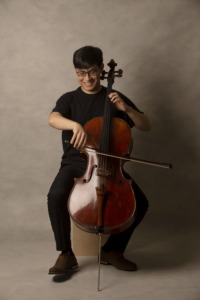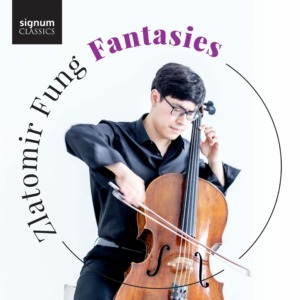In an article written for The Arts Desk, reprinted here with permission, Zlatomir Fung talks about his debut album on Signum Records, Fantasies, with its fresh takes on Janáček’s Jenůfa and Bizet’s Carmen on the menu
My new album, Fantasies, recorded with pianist Richard Fu, is the culmination of my years-long fascination with the wonderful genre of instrumental opera fantasies. I first fell in love with opera fantasies while attending summer music camps as a teenager. Franz Waxman and Pablo De Sarasate’s fantasies on Bizet’s Carmen were staples of the summer festival repertory of my violin-playing peers, and they were my first exposure to this sub-genre. As an ambitious young cellist, I couldn’t help but feel envious. Something about the virtuosic nature of the music—like a daring, high-wire circus act—thrilled me as a listener. As I watched my colleagues effortlessly whip up scales in tenths, I wondered: “Why can’t cellists do that?”- or, perhaps more appropriately, “Why don’t cellists do that?”
I like to imagine that the great cellists of the 19th century wondered the same as they witnessed their violin- and piano-playing counterparts flourish in the heyday of instrumental virtuosity. The ambitions of the great cellist-composers of that era—Servais, Popper, and Piatti, among others—are beautifully realized in their many concert works, which collectively advanced the possibilities of cello technique and continue to inspire composers today. In their operatic fantasies, we see some of the first extensive examples of techniques like octaves, artificial harmonics, and extensions in thumb position. These technical ideas heightened the expectations of a virtuoso cellist’s technical capacity—elevating the status of the cello to be more of an equal to piano and violin—and laid the groundwork for the cello writing of practically every prominent composer since. Two of the 19th-century works featured on the album—Adrien-François Servais’ La Fille Du régiment, op 16, and François-George Hainl’s Fantaisie sur des Motifs de Guillaume Tell—are excellent and early examples of this forward-thinking virtuosic writing.

Zlatomir Fung
Photo I-Jung Huang
While discovering these obscure works during the pandemic lockdown, I fell in love with the spirit of the genre, which exemplified instrumental freedom and personal expression. Nonetheless, I was still searching for a satisfying fantasy on my favorite opera, Carmen. By the time Carmen became an established classic, many prominent virtuoso cellists of the early and mid-nineteenth centuries had passed. The popularity of the genre of the opera fantasy, once a significant vehicle for virtuosos (Servais alone wrote around two dozen before he died in 1866), was itself beginning to wane. The most notable fantasies on Carmen for cello and piano are those by Joseph Hollman (a pupil of Servais), published in 1885, and by Buxton Orr, written about a century later in 1985. Unfortunately, Hollman’s fantasy lacks virtuosity; it is about as challenging as a standard concert piece from the era. Orr’s fantasy is quite a bit more successful, but as a listener and player, I found the overall demeanor of the arrangement to be a bit languid. If I were going to perform a fantasy, I felt it was important that it reflected my tastes and personality as a cellist. My dream was to be able to play a Carmen fantasy that captured the furiously concentrated musical energy of the original operatic score.
Marshall Estrin, the composer of Fantasia Carmèn (the final track featured on the album), is one of my closest friends and musical collaborators. We met at the Juilliard School as students and quickly became friends, bonding over our love of film. Within a few years, he had already written a substantial solo cello piece for me, Kitaroidía. It pushed my technical limits to the brink, so I was curious to see what he might do with a hypervirtuosic fantasy on Carmen. I had confided in him my dream of a great Carmen fantasy for cello and piano as early as 2018, and in 2022, the project finally came to fruition.
In Fantasia Carmèn, Estrin takes the notion of a “fantasy” and deconstructs it in the best possible way. Estrin aims to create a world onstage that exists only inside the mind of the cellist: the audience members are observers as the solo cellist recalls tunes and moments from Carmen with a fickle, laissez-faire attitude. Even the pianist is a mere figment, subject to the whims of the cellist’s imagination. Achieving this striking performative effect requires the cellist to perform unconventional tasks for classical musicians, such as speaking in French, muttering to oneself, and acting out physical comedy.

Zlatomir Fung
Photo I-Jung Huang
Adapting Fantasia Carmèn into an audio-only version for Fantasies was a stimulating challenge. How would it be possible to convey physical movement with just sound? How would the spoken elements make any sense without visual reference? How would we manage without audience laughter, which had become an integral part of the piece? The adaptation process was arduous. Marshall and I collaborated on finding a solution for over six months, going through dozens of drafts for a script, driving the album’s editors crazy. (Thank you, Mike and Nick—we owe you one!). We looked to techniques from radio drama for inspiration. Perhaps we could add a new character (or two) to create a dialogue or “situation” where a cellist would improvise the virtuosic fantasy. Maybe we could add a laugh track for the funny moments; if the audience were to become confused, they would at least know why.
We finally got to the heart of the problem: Fantasia Carmèn is meant to be performed live. The imperfections of a live performance—the very things one aims to eliminate when professionally recording an album—are the central idea of the piece. In a live performance, the solo cellist attempts to execute an array of hypervirtuosic cello techniques in 20 minutes, with no breaks. Since the piece is happening in the private fantasy world of the cellist, the mistakes (which are inevitable!) can be shrugged off. The fundamental ridiculousness of trying to play something so hard is part of the appeal; if the performer perfectly succeeds, it loses the comedic spark.
This realisation was ultimately the nadir of our process. At one point, we considered releasing the work without extramusical elements, rendering it a “normal” fantasy. But after months of contemplation, Marshall and I came up with a solution that satisfied both of us. While still a compromise, we believe it allows the work to stand on its own while providing the audience a glimpse into the piece’s original spirit. Our ultimate hope, of course, is that intrigued listeners and fellow cellists seek the work out in a live context, where it can be enjoyed in its original conception.
Alongside the odyssey of Fantasia Carmèn was my journey into the world of composing my own fantasy on Leoš Janáček’s Jenůfa. My original hope for the album was to write a fantasy on George Benjamin’s opera Written on Skin, but I could not get the proper permissions. Jenůfa was recommended to me by Marshall as an alternative. I was only somewhat familiar with Janáček’s music, so being thrust into the world of one of his most well-known operas was a fascinating aesthetic encounter. For many months, I listened to the opera without referencing the libretto, trying to identify the moments that most enraptured me musically. The dark, engrossing storyline of Jenůfa is one of the opera’s most compelling elements, but I wanted to work solely with the musical elements to bring across the riveting tensions of the opera in a cello-piano arrangement.

In writing Fantasy on Jenůfa, I wanted to synthesize everything I loved about opera fantasies. My first objective was to prioritize idiomatic, virtuosic, and enjoyable cello writing. As a player, I’ve always fancied exploring lyricism, line, and continuity of phrasing more than raw technical execution. Much of the Fantasy, especially the first half, is directly vocal, taking the sung lines from different characters in the opera. I also aimed to construct a fantasy that mirrored the source opera’s emotional textures. Unlike the 19th-century operas that were typical material for virtuosic transcription, Jenůfa favors a continual stream of musical ideas, transitioning between sections without pause, often abruptly, and to jarring effect. I hoped to convey this peculiar sense of continuity during transitions between the major musical sections of the fantasy. Tying these two priorities together was my hope that the fantasy would be emotionally authentic to the original work, expressing the yearning, passionate terror that Janáček explores in his opera.
Including two 21st-century opera fantasies on the album was essential to my original vision for the project. At the heart of it lies my pure enjoyment of these virtuosic medleys. They have limitless possibilities and are downright fun. Although two new fantasies can hardly be considered a rejuvenation of the form, I hope interested listeners sense that the genre is still ripe for exploration. In my country, the United States, live opera remains a privilege for those who live in large urban areas. At a time when opera companies all over the world are striving to create meaningful work, I believe that a robust tradition of fantasies on new operas—allowing performers to popularize the music in venues and locales where they might never appear in their original form—is one way to help opera continue to be a vibrant art form. I won’t be able to write a fantasy on Benjamin’s masterpiece Written on Skin, but I hope to write and perform fantasies on other significant contemporary operas. Maybe this album will inspire others to do the same.
Watch our BBT film about the recording of Fantasies here
